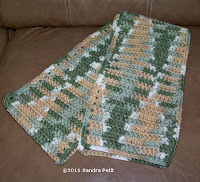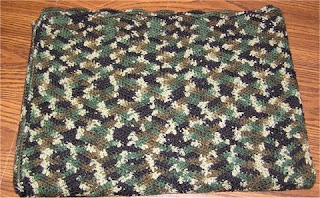So just what IS flashing and pooling?
Going back in time, I am happily working away on an afghan done with variegated yarn. It will take many skeins of variegated yarn to finish but it goes quickly and I am enjoying the process. About halfway through I pick up the afghan to have a look and to my horror, the second of three skeins has made a zigzag pattern in the afghan. It is very obvious. The first and third skeins work fine. Now had the pattern appeared throughout, no problem. But this was a problem.
At that point, there were only a couple of options. One was to continue, ignoring the flashing. The other was to rip it back and rework it.
What might one do if you catch this early? You could cut out a section of yarn to disrupt the color pattern - but don't just cut out the strip that contains all the colors or you'll be right back where you started. You could also pull the skein from the opposite end. Another option is to alternate skeins, but keeping the same color sequence.
 The scarf from yesterday demonstrates Color Flashing. Color Flashing is when you get an unintentional pattern when using variegated or ombre yarns. The above mentioned scarf from yesterday had flashing and here is another with a very similar case of flashing. It didn't matter in these cases as I rather liked the pattern it made.
The scarf from yesterday demonstrates Color Flashing. Color Flashing is when you get an unintentional pattern when using variegated or ombre yarns. The above mentioned scarf from yesterday had flashing and here is another with a very similar case of flashing. It didn't matter in these cases as I rather liked the pattern it made.Color Pooling is similar. It is when the same colors "pool" near one another, creating a sort of splotch or spot in various areas as you work. A "cow" sort of look would be an example of pooling. If that's the look you're going for, no problem. If not, you need to mix it up. (In flashing you may also have pooling and you could possibly consider pooling to be an "unintentional pattern".)
The afghan below which I made for my son shows pooling. You can particularly notice how the black is gathered in spots. He didn't care so this one worked for us.
 The hats at left use a similar camo yarn and show pooling of the colors which also makes a pattern, so I guess it has a bit of both. Note the cream colors all on top of one another and the greens and browns in the same spots. Sort of makes a vertical striping pattern.
The hats at left use a similar camo yarn and show pooling of the colors which also makes a pattern, so I guess it has a bit of both. Note the cream colors all on top of one another and the greens and browns in the same spots. Sort of makes a vertical striping pattern.Pooling is easier to spot because you will see that you always seem to end up working dark brown over dark brown, for example. You will see this pretty early on and can decide to either continue or rip back or change at that point.
In doing a bit of research I found that some people use these terms interchangeably, though you don't see them thrown around much.
One additional note. I mention variegated and ombre yarns. These are NOT the same. Ombre means that the skein contains shades of the same color - like shades of brown or shades of blue, whereas variegated contains entirely different colors - like red, white and blue for example.
Variegated and ombre yarns are wonderful and can add a bit of color and innovation to your projects. You just need to be aware of the pitfalls as well. These yarns are particularly wonderful for small projects where pooling and flashing aren't a big concern, like butterflies, potholders and dishcloths, placemats, granny and sampler squares, and such. If you can find a matching solid color that appears in the variegated yarn, you can make a lovely afghan.
Happy crocheting!




Great coverage of important crochet topics! Typically I don't mind flashing or pooling in what I'm making although there are instances when making clothing where the location of the resulting colors can be awkward.
ReplyDelete